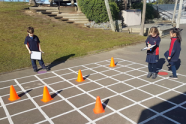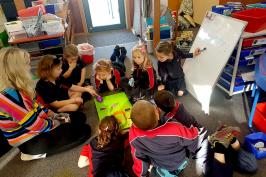A STEAM approach to introducing computational thinking
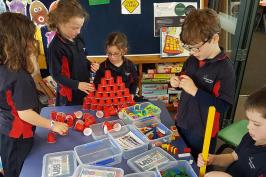 STEAM activities with years 2–3 students
STEAM activities with years 2–3 students

Years 2–3 students at Grant’s Braes School on the Otago Peninsula learnt about the nature of technology.
Through STEAM activities they began to understand technological practice.
They learnt about computational thinking as a skill used in technological practice by engineers.
Using a STEAM approach within the technology learning area
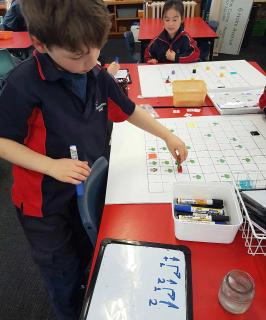 A STEAM programme of learning
A STEAM programme of learning

Teachers Jess and Shannon designed a programme of learning that combined a STEAM approach with the technological areas designing and developing materials outcomes and computational thinking for digital technologies.
STEAM is an educational approach to learning that uses science, technology, engineering, the arts, and mathematics as access points for guiding student inquiry, dialogue, and critical thinking.
The programme of learning they designed included the following.
Nature of technology, characteristics of technology
- Developing an understanding of what technology is and how technologists work by exploring the work of a robotics engineer
Computational thinking for digital technologies, progress outcome 1
- Students use their decomposition skills to break down simple non-computerised tasks into precise, unambigous, step-by-step instructions (algorithmic thinking) – learning about computational thinking using unplugged activities
Technological practice and technological knowledge
- Playing with STEAM kits to gain confidence with computational thinking and learning to make models of structures using a range of materials
The nature of technology
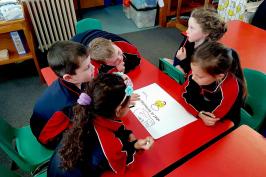 Nature of technology and STEAM
Nature of technology and STEAM

The students were introduced to the concepts of the technology learning area as purposeful intervention by design and the human made world. They viewed and discussed the video, What’s an engineer?.
This was an opportunity for students to think about these questions:
- What is technology?
- What is the human made world and what do we make?
- How do engineers work?
- What do engineers design and make?
- What is the purpose of some of the things that engineers design and make?
- Do you think it is important for engineers to be able to work with others?
What contributed to success here?
Exploring an engineer’s occupation proved to be effective to develop an initial understanding of technology. See the characteristics of technology component within the nature of technology strand of the technology learning area.
Achievement objectives at level 1 for the nature of technology strand are to:
- understand that technology is purposeful intervention through design
- understand that technological outcomes are products or systems developed by people and have a physical nature and a functional nature.
Questions to consider
-
What are other occupations that involve purposeful intervention by design and the human made world?
(For example, food technologist, software engineer, computer programmer, materials technologist, fashion designer, builder, or joiner.) - What do we learn about in the technology learning area in comparison with other STEAM learning areas in the New Zealand Curriculum such as mathematics, science, and the arts?
-
How will you include diverse examples of successful technologists to engage your students?
For example Ezel Kokcu.
Computational thinking for digital technologies using unplugged activities
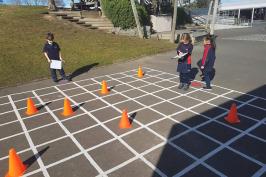 Robotic engineering and programming
Robotic engineering and programming

The class were introduced to robotics and an opportunity to have a discussion on how engineers also make robots that require programming – and how programming requires computational thinking.
The students could see that beginning to understand computational thinking and simple programming could help them in the future to control or make items.
The students were introduced to computational thinking in an unplugged setting using grids outside and inside. The activities involved giving instructions to kidbots to reach a certain point on a grid.
What contributed to success here?
Introducing robots as something an engineer might make provided another example of technology as intervention by design. Watching videos such as the automated warehouse can give students an understanding that engineers make for a purpose in a variety of ways. These include constructing with digital tools such as programming, as well as constructing with materials.
The students were beginning to understand technological products are objects that have been designed by people and developed through technological practice to serve particular functions. Technological products is a component of the technological knowledge strand.
Through the unplugged activities the students were beginning to develop understandings in progress outcome 1 for computational thinking for digital technologies. They could use their decomposition skills to break down simple non-computerised tasks into precise, unambiguous, step-by-step instructions (algorithmic thinking). They could give these instructions, identify any errors in them as they are followed, and correct them (simple debugging).
Questions to consider
-
What examples of robots or programming will engage your students?
App saving indigenous Alaskan language is an example of New Zealand software engineers helping solve a problem. - How will you link the unplugged activities to computational thinking for digital technologies?
STEAM activities and technological practice
The engineering process
Students now knew that engineers make things for a purpose. They watched the engineering process video. This video outlines a process that engineers may follow when designing for a purpose. Students could see that this design process is not always linear. The engineers could revisit stages – an iterative design process.
The STEAM rotation activities set up as part of this programme of learning provided opportunities for students to engage in some of their own technological practice – closely supported and guided by the teacher.
In rotation, groups of students worked their way through kits.
Computational thinking skills
Several kits included practising their newly acquired computational thinking skills in unplugged activities and computerised activities using simple programmable robots. For example, the students used a coding mouse to develop and create a code to get the mouse to the cheese. They could put obstacles in place for the mouse to manoeuvre around. The children debugged their code if the mouse did not make it to the expected destination.
Technological knowledge
The kits included a range of activities that built skills and confidence in making products with a variety of materials. For example, one kit contained plastic cups. The students were asked to build a structure (such as a tower) that was a model of an image provided in the kit.
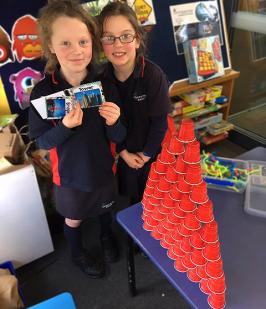 What contributed to success here?
What contributed to success here?

Asking students to work and play with a range of materials has direct links to the technological products component of the technological knowledge strand.
The achievement objective at level 1 for technological products is: understand that technological products are made from materials that have performance properties.
Learn more about this achievement objective through the technological products indicators of progression.
The technological practice strand of the technology learning area has three components brief development, planning for practice, and outcome development and evaluation. These components provided a framework for the students to engage in their own technological practice in the different activities and to reflect on the practice of others.
The students embedded their understandings in progress outcome 1 for computational thinking for digital technologies and were developing understandings relating to progress outcome 2.
Questions to consider
- What different activities could you provide to embed students’ computational thinking skills?
- How will you help students incorporate revisiting steps and redesigning as part of technological practice?
- What materials could you provide students to think about their properties and how they might be used to create a product?
- When doing many short activities what parts of technological practice will you highlight?
Explore technological products in the technological knowledge strand
Watch a short video about materials.
Technological products
Explore outcome development and evaluation from the technological practice strand
Watch a short video that discusses the different aspects of outcome development and evaluation.
Outcome development and evaluation
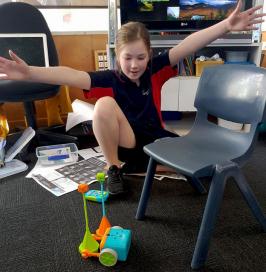 Summary
Summary

The teachers introduced the technology learning area through looking at an engineer – what they make, why they make it, and the process they follow.
They did this through watching engineering videos and taking part in a rotation of STEAM activities.
They learnt about the nature of technology and technological practice.
To create technology the students looked at how engineers may use materials (technological products) and programming. They learnt programming involved computational thinking.
The rotation of activities helped the students to develop their basic understanding of technological practice, technological products, and computational thinking.
You might also like...
Getting started with the learning progressions for digital technologies in primary
Watch a webinar by three primary school teachers.
Local curriculum in technology using a light festival
In this teaching snapshot STEAM primary teacher Sarah Washbrooke uses the STEAM approach to acknowledge the technology learning area draws on multiple disciplines.
CS Unplugged: Kidbots unit plan
In these activities students explore programming language, and are supported to understand that programming is about working together.

